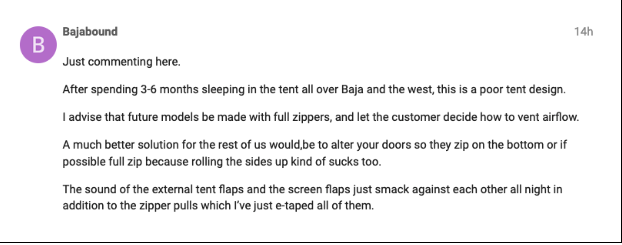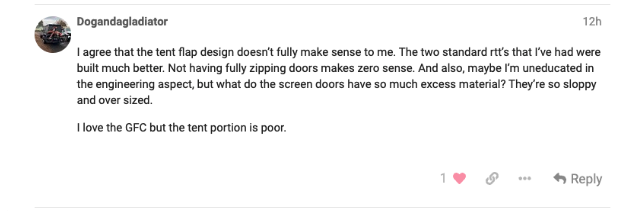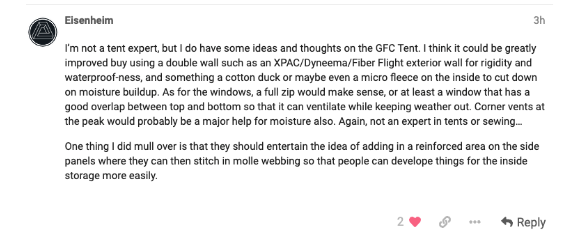I first off want to say how awesome the GFC community is and this forum. It’s pretty hard to find a RAD group like we have here. It’s honestly one of the reasons why I purchased the GFC - there is NOT one other company who has such a sick community. A community that can connect, give advice, share amazing builds, and more. Literally this forum is built on the backs of the consumers - with them, this forum would be nothing.
Moving on…
I will speak on what I feel is the main concern of many folks (especially after chatting with other owners during the meet up). It comes down to ~ 2-3 factors:
-
How can we seal the tent when exposed to the elements AND
-
How can we vent the tent to mitigate some of the condensation issues when said elements are present (snow, rain, wind, etc.) AND
-
How can we also possibly have some privacy (zip down windows wink wink) + still allow airflow in the tent
I don’t hear many if anyone complain about the space frame, floor, strength of the shell, etc. Again, this is purely the tent design/window orientation layout. Everything else about the GFC besides the tent insert is RAD. I/many others don’t expect an Alucab for the price point of a GFC. However, these request are low hanging fruit that could truly excel the whole GFC product line.
If we can prevent the wind/rain/snow from entering the tent when camping in those extreme elements, that would lead to a “warmer” tent imo but correct me if that is wrong. There is a reason why folks who use the tent through all 4 seasons are making modifications to combat this issue such as adding maxair fans (@Julian has added this and many others), headliners (@Dogandagladiator has added this as well as @the_philxx and myself), or more. Being made in Montana, it should be expected that users are not only going to huck the heck outta this thing but camp in some pretty extreme elements.
While the passive ventilation is awesome, you have other competitors in the industry who are placing vents where the hot air is sitting/rising in the tent - the top back corner. Super Pacific has a very unique way of opening/closing their vent. This still allows some airflow if the tent has to be fully closed (or closed the best it can) in rain/snow. I get the triangles near the feet are supposed to help but again, my hot breath isn’t going towards my feet, it’s going to the top wedge. While these vents may not be the 100% solve all solution, from previous experiences with other RTTs, they do something and they help. I am no engineer but as an active user/camper with quite a bit of experience under my belt in various conditions…I can say for sure I miss the vents/window layout of other RTTs like the CVT Mt Hood. I think @nat3060 can even vogue for missing the sealed windows + vents of the iKamper. There is a reason why users are applying snap clips, velcro, etc. at the bottom of the windows - they want to be able to close the tent in this situations.
The user/consumer should have the ability to seal up the tent if they wish and vent the tent as they wish. Right now, we don’t have the ability to do so unless self done modifications are done which don’t always have the most success. Lastly, if we do make some of these modifications, we automatically void the warranty of the tent.
In response to this:
Out of curiosity, would you like to see a retrofittable solution to seal the ventilation features of the tent for those using diesel heaters? Or would you prefer to trade cost, mattress thickness, ease of closure, and/or overall height of the RTT to fit a double-walled tent and reduce the draftiness?
I personally don’t think there needs to be a double walled tent and after talking to some of the folks at GFC, it seems like there isn’t a true “doubled walled” RTT on the market (again, correct me if I am wrong on this). Not even Alucab, Super Pacific, or AT overland (as far as I am aware). It’s the weight of fabric being used or the material (marine grade, etc) being used that makes the difference especially after comparing the fabric used across companies. Certain materials like Polartec Power Shield w/windbloc membrane can block 99-100% of the wind - I don’t see how this would sacrifice the ease of closure, mattress thickness, or overall height of the RTT. Even if the overall height of the RTT had to increase 0.25 to 0.5in, it would open up so many more possibilities that probably many would opt for. Also, I highly doubt with the naked eye, someone would see 1/4 inch difference unless it was specifically pointed out. Again, I am not an engineer but I speak on real world experience. I use the heck out of your product and have real world experience - to me, that is something you can’t put a price on when looking for feedback, potential changes, etc.
So whoever is now running the forums or the official GFC forum profile, I hope you can take this as feedback. Yup, I am going to be the squeaky wheel on this matter because I truly care about the development and future of the company. It’s a RAD fudging company and I love supporting something so close and local… but when feet are dragged with updates/potential modifications, it’s frustrating. Take a stroll through these forums and YouTube videos/comments and I am sure you will find similar requests/or personal dilemmas on purchasing a GFC or RTT because of the above.










